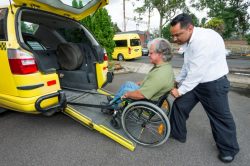Ensuring Safe and Compliant Transportation for Wheelchair Users in Victoria
As healthcare professionals, we know that ensuring the safety and comfort of your clients with mobility challenges is one of your top priorities. One aspect of care that significantly impacts the quality of life is transportation. In Victoria, accessible vehicles and the equipment used inside them must follow specific requirements to ensure safety during travel.
With this guide, we aim to refresh you on these requirements, helping you make informed decisions for your clients.
The Law
In Victoria, the law relating to travelling in a wheelchair-accessible vehicle is primarily contained in the Commercial Passenger Vehicle Industry Act 2017. The primary focus of this article is to outline the required specifications for wheelchair-accessible vehicles. There is much detail in this regulation, but the key points from this legislation are:
- The vehicle must have a tie-down system that attaches to the wheelchair at four points.
- The vehicle must have a lap sash or a harness-style belt to arrest the client in case of an accident.
- The wheelchair must be positioned in a forward-facing direction.
It is worth noting that these rules do not mention any requirements for wheelchairs. By extension, then, there is no legal requirement for a wheelchair to be crash tested to be allowed to travel in an accessible vehicle.
The Safe Transport Victoria page on wheelchair-accessible vehicles is a great resource for this topic.
Occupied transport with other types of mobility aids, such as a scooter, a princess chair, or a rollator, is specifically forbidden, as doing so puts their safety and the safety of other occupants of the vehicle at risk.
Duty of Care
Although there are no legal requirements relating specifically to the design of a wheelchair for occupied transport in Australia, as Assistive Technology prescribers, we have a duty of care to our clients to ensure the equipment we provide is safe and fit for purpose. Transportation requirements should be considered by the therapist during the assessment process and prescription of a wheelchair.
If a wheelchair is to be used for occupied transport, it is strongly recommended to select a wheelchair that has been crash tested in accordance with AS/ISO 3696.19 and a seating system (if required) crash tested in accordance with AS/ISO 16840.
Along with ensuring standard compliance, it is best to…
- Specify a back support of at least shoulder height.
- Specify a head support to reduce the effects of whiplash.
- Ensure postural support devices and cushions are well secured to the wheelchair.
- Encourage users to remove trays and other ancillary items during transport.
Additional Safety Requirements are Imposed by the Operator
Some transport operators (such as bus operators) impose additional safety requirements as part of their own risk mitigation practices. These can include the use of a pelvic positioning belt or a harness. Be sure to check with these operators if required during the prescription process.
Did you know?
- The safest way to travel in a motor vehicle is to transfer into the included seats. Consider if this is feasible before investigating occupied transport.
- Positioning aids such as a belt or harness are not intended to secure the occupant in case of a crash. While maintaining a good, safe posture during occupied transport might be desirable, these are not intended to replace a seatbelt.
- AS/ISO 3696 (the crash testing standard) allows for a wheelchair to be tied down directly to the frame or via dedicated tie-down points. Just because a wheelchair does not have dedicated tie-down points does not mean the chair is not crash-tested. Always refer to the owner’s manual for the chair to determine the correct anchor points for a wheelchair.
- If occupied transport is identified as a requirement during the prescription process, it is advisable to test fit the chair in the vehicle if possible. It is best to ensure the chair fits and the tie-downs are compatible before the client gets their equipment.
At GMobility, we understand the need for safe and accessible transportation for your clients with mobility challenges. We select our range of equipment with these criteria in mind, ensuring compatibility with accessible vehicles and adherence to the highest safety standards. Our knowledgeable team of Assistive Technology Specialists is available to guide and work with healthcare professionals in choosing the right equipment, offering trials, and providing support for optimal setup and use.
We work collaboratively with healthcare professionals to enhance the quality of life for those with mobility challenges by ensuring their transportation is safe, comfortable, and tailored to their needs. For more information on our products and services, or to arrange a consultation, please contact us.
If you require more assistance in choosing the right equipment to suit your needs, contact our team today for more information. You can call us on 1 300 00 4662 or send an email to info@gmobility.com.au.

 Log In
Log In
